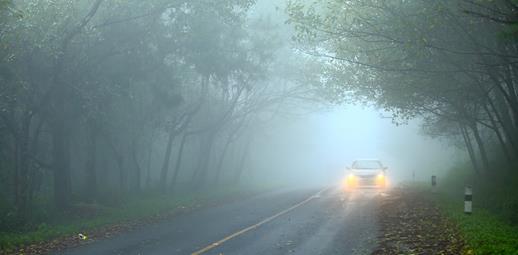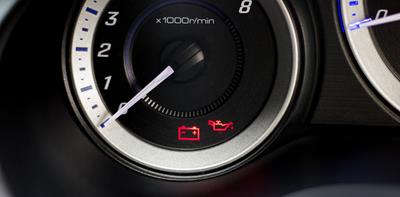
Driving in fog can be challenging for many drivers. It lowers visibility and makes it harder for you to spot any upcoming hazards. So how can you stay safe driving in foggy weather conditions?
Here’s everything you need to know.
Easy as hack
If driving visibility is less than the length of a football pitch, it’s time to turn on your fog lights.
At a glance
- Fog lights are generally only needed when it’s foggy
- If used at other times, they can mask your brake lights. You could even get a £50 fine for using your fog lights in the wrong way
- The purpose of fog lights is to help other drivers see you, not for you to see in the fog
How to drive in fog
You need to know how to drive in foggy weather conditions if you want to stay safe. So, here are 10 steps to follow:
1. Drive slowly
If there’s a lot of fog, you might not be able to see how fast or how slowly other cars are driving, so be cautious and drive slowly to prevent any accidents. This is also crucial if you’re driving in fog at night.
2. Check your mirrors
Always keep an eye on your mirrors when you’re slowing down and before you enter the fog so that you’re aware of your surroundings.
3. Be aware of fog signs
If you see a sign saying ‘fog’, but the road seems clear, be prepared for a foggy patch up ahead.
4. Turn on headlights
If you can’t see more than 100 metres in front of you, you should turn your headlights on. This also helps other drivers see your car.
If the fog is thick and visibility is seriously reduced, you should use your front or rear fog lights. But remember, you must switch them off when visibility improves as they dazzle other road users and can obscure your brake lights.
5. Keep a safe distance
Maintain a good distance from the vehicle in front to avoid any harsh or sudden braking.
6. Use your windscreen wipers and demisters
Improve visibility by using windscreen wipes and demisters.
7. Use roadside reflectors
Keep an eye on the reflectors and use them as a guide when you’re driving so that you don’t drift out of your lane.
8. Listen to traffic
Pay attention to your surroundings by opening your window a bit. This will help you hear what’s going on outside, which improves awareness of what’s near your car.
9. Be vigilant
Expect to encounter other drivers not using their fog lights.
10. Park safely
If conditions are extreme, park safely and wait until the weather improves before continuing your journey.
How to prepare your car to drive in fog
Before hitting the road, make sure you and your car are fully prepared for the journey.
You can do this by:
- Making sure all your windows are clear so that you can see while driving
- Making sure car lights are working properly
- Fuelling up if needed
- Checking the weather forecast – if there’s a weather warning in place, you might want to avoid driving
- Planning your route beforehand so that you avoid busy roads and extra traffic
What shouldn’t you do when driving in fog?
We’ve mentioned what you should do when driving in the fog, but what about the things you should avoid doing?
Here’s what you should avoid:
- Using full beam – as the fog reflects the light back further reducing visibility
- Relying purely on automatic lights – they might not come on when you’re driving in the fog so double check
- Tail another car – always keep a safe distance between other vehicles
- Speed up – make sure you drive cautiously. Don’t speed up even if a vehicle is tailing you
- Use cruise control – you want to make sure you have as much control as possible over your car in foggy conditions
What are fog lights?
Fog lights are car lights that should only be used in the fog, when visibility drops below 100 metres. They are usually placed below the headlights to help you get a clearer view of the road.
Do all cars have fog lights?
Yes. Rear fog lights are required by law on all cars in the UK. Front fog lights are more likely to be found as an extra on higher-spec models. Some newer cars have daytime running lights (DRLs) instead of fog lights. These are the bright LED lights you see on new cars, which are permanently on and designed to make the car more visible to other road users. DRLs should not be relied on in fog, especially as they are often only illuminate the front lights.
While it’s not a legal requirement to use your fog lights, if they’re needed it’s safer to switch them on. Their purpose is to help make your car visible to others, rather than enabling you to see further in the fog.
How to use fog lights
If you aren’t sure how to turn your fog lights on or off, spend a few minutes getting to grips with them while your car is stationary. That way you won’t suddenly have to figure it out one bleak winter’s morning when you’re in a rush.
Fog lights are usually operated by a separate switch from the main light controls. If you can’t find it, check your car’s manual for guidance. The switch will also have the fog light symbol on it, which is an oval-shaped lamp with three diagonal lines intersected with a wavy vertical line to the left of it.
Look for a dashboard light coming on to let you know the fog lights are on. And if your car has automatic lights, don’t assume your fog lights will come on automatically too.
When do you need your fog lights on?
It’s not always clear when fog lights are needed. It all comes down to the difference between fog and mist, which is a bit of a murky area. The Met Office says:
- Foggy is when you can see less than 1,000 metres ahead
- Misty is when you can see further than 1,000 metres
But from a driver’s perspective, visibility distances are much smaller. In fact, you should turn your fog lights on when visibility dips to 100m (328 feet) or less. That’s roughly the length of a football pitch and means the fog is reasonably thick. You should also use your headlights too, but not your full beam.
Are there any other times I should use fog lights?
Fog lights are for reduced visibility on the road but you should not use them if visibility is less than 100 metres due to rain, snow or hail.
Remember, fog lights are to help other road users see you, not the other way around. So, you will also need your headlights on low when driving in fog.
When should I turn my fog lights off?
According to the Highway Code, ‘you must not use front or rear fog lights unless visibility is seriously reduced as they dazzle other road users and can obscure your brake lights. You MUST switch them off when visibility improves’.
If you misuse your fog lights, you could be fined up to £50.
You can find out more about our car insurance here.


